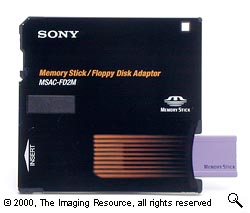|
|

| |
Sony MVC-CD1000
(NOTE: This camera is not in stores yet.
Projected ship date is early August, 2000)
Page 3. FlashPath - An Interim Solution |
 |
 Running out of steam: The capacity crunch Running out of steam: The capacity crunch
As noted above, the floppy disk fulfilled all the requirements of the "Way" when typical image file sizes were under 100K, but had an increasingly hard time as resolution and file sizes grew. One possible solution to the crunch appeared in the form of the FlashPath adapter for Memory Sticks. This clever gadget was developed by SmartDisk Corporation, as a variation of their earlier units created for use with SmartMedia cards. The (exact) size and shape of a floppy disk, the FlashPath could be inserted into a computer's floppy-disk drive, and be read and written to just like a standard floppy. Well, almost... The FlashPath required custom driver software to be installed on the host computer to trick the floppy drive into dealing with the odd, non-rotating device. Also, quirks of the Macintosh floppy drive design precluded the ability to write to the FlashPath, restricting its use as a read-only medium. (Not a major problem for digicam usage, since the main objective is to read images from the memory card into the host computer.) The special version of the FlashPath adapter created for Sony accepted Sony's Memory Stick memory cards, and had special firmware to allow it to work with the latest Mavica designs. (Sorry, pre-2000 Mavicas can't use the new FlashPath memory solutions.)
The FlashPath approach relieved the capacity crunch, as Memory Sticks are currently (June, 2000) available with capacities as high as 64 megabytes. They unfortunately violate the other two principles of the Triune Way however: They're expensive (the FlashPath itself sells for about $100, and a high-capacity Memory Stick is another $100 or more), and some of the universality is lost. True, most computers can be made to read FlashPath devices, but doing so requires the installation of software drivers. While this installation process is simple enough, it's enough to stop many consumers in their tracks. So, the FlashPath/Memory Stick solution was only a partial solution, and one not likely destined to be popular.
<< The Triune Way of Media Nirvana | Out of the Blue: CD-R in a Camera >>
Reader Comments!
So what do you think of the new Sony CD1000? Is it the future of digital? The last of the digicam dinosaurs? Would you buy one? Click here to leave a comment! (Read what's here, then add your own!)
Questions? Problems? Email us!
This document copyright (c) 2000, The Imaging Resource, all rights reserved. Visitors to this site may download this document for local, private, non-commercial use. Individuals who have themselves downloaded this page may print a copy on their personal printers for convenience of reading and reference. Other than this explicit usage, it may not be published, reproduced, or distributed in print or electronic and/or digital media without the express written consent of The Imaging Resource.
|
 |
|
